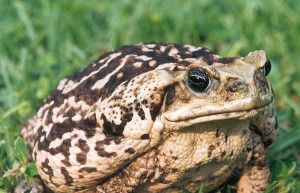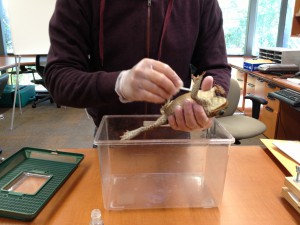When biologists identify the range of where a species is found throughout a particular state, it is commonly done so by breaking up the state into three sections: north, central and south. For us in Pinellas County, that means we can focus on what is found in the central region. When it comes to frogs (which include toads), the central region is home to 16 of the 27 native Florida species, and unfortunately, to all three of the non-native species.
In the past I wrote about the invasive Cuban treefrog, so today we are going to switch the focus over to the invasive Cane Toad or what some refer to as the Bufo Toad or Marine Toad (Rhinella marina). The third non-native species is the Greenhouse Frog, but it is not considered invasive (yet) and thus is not known to cause harm to our native species or ecosystem, the economy or human health. The Cane Toad on the other hand, has quite a different story…
Cane Toads are the ones that you don’t want your dog to get a hold of because if they bite or swallow this toad, they will become sick and are at risk of dying. These toads are relatively easy to identify just by size alone. At maturity, they are usually between 4-6 inches from head to rump, but have been found as large as 9.5 inches! A good rule of thumb is that any toad in Florida that is larger than 4 inches is most likely NOT native and could be an invasive Cane Toad.

These toads are considered invasive because they eat our native frogs, lizards, snakes and even small mammals! As previously mentioned, they also pose a threat to our pets because they secret a toxin from their parotoid gland, located on the shoulder area of the frog. This toxin can also irritate the skin and eyes of people. Signs and symptoms to look out for from Cane Toad poisoning in pets include:
- excessive drooling
- extremely red gums
- head-shaking
- crying
- loss of coordination
- convulsions (although not as common)
For the safety of you and your pets, it is good practice to catch and identify ANY toad you see in your yard (using gloves to protect your skin). If you properly identify the toad as a Cane Toad, you should humanely euthanize them. This can be done by rubbing or spraying 20% benzocaine (often found in toothache or sunburn treatments) on the toad’s lower belly. Then, place them in a container while the benzocaine works through the toad’s skin and in a few minutes it will become unconscious. Once unconscious, place the toad in a sealed container in the freezer for 24-28 hours and then dispose of it in your trash.

Help keep our environment, and your neighbors safe by doing your part to help control invasive species in our area. If you ever have any questions, please feel free to contact me below. Thank you!
Oh, and you can always sign up for the Invader Updater to stay up to date on invasive species in Florida.
 0
0
